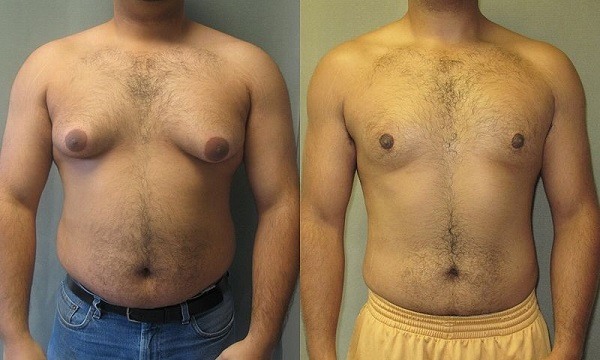What does Gynecomastia mean?
Contents
The term derives from the Greek words of gynae and mastos, which mean woman and breast respectively. It refers to the development of female-like breasts in men. Broadly speaking, the term ‘man boobs’ is used to describe the appearance of breast-like fatty deposits in overweight men as well as the benign enlargement of glandular breast tissue, but only the latter should truly be described as gynecomastia. This condition is diagnosable once more than 0.5cm of firm gland becomes palpable behind the whole areola (that’s the pigmented area of skin around your nipple). Gynecomastia is in fact quite common, and predominantly affects men in old age as well as infants and pubescent boys.
Levels of Gynecomastia
The condition is traditionally classified from grade 1 to 4 based on the width of enlarged breast tissue (as measured using calipers). The mildest form is characterized by ≤2 cm with no skin sag, but with one or more movable nodules palpable beneath the areola. Moderate grade 2 gynecomastia presents a tissue width of 2-4 cm which extends beyond your areola but with no change in shape or sagging. Grade 3 describes 4-6 cm of ductile tissue as well as extra skin and the beginnings of pouting or sagging breast shape. Grade 4 describes anything more severe than that.
Types of Gynecomastia
In addition to the four degrees of severity, there are seven diagnosable ‘types’ of gynecomastia defined by the morphology (shape) of the breasts. Typical appearances used as a guide for each type are as follows:
Type 1: a sensitive, puffy nipple. Breast tissue is the size of an egg, extending just beyond the areola, creating a small cone-shaped breast.
Type 2: the most frequent type encountered by clinicians. Excess breast volume about as big as a tennis ball, but a smaller chest angle than 45 degrees.
Type 3: a greater chest angle at 45-60° and mild sag. with only mild breast sag.
Type 4: an angle of 60-90° in addition to noticeable chest sag.
Type 5: a >90° angle with significant sagging.
Type 6: extreme sagging, with the upper part of areola above the fold of the chest.
Type 7: extreme sagging, with the areola starting below the fold.
Bilateral, Unilateral or Asymmetrical?
Most cases are bilateral, but unilateral cases do occur. In bilateral cases, both breasts are affected, though not necessarily to the same degree. Unilateral gynecomastia means that only one breast is affected, while the second remains normal in both shape and size. Asymmetric gynecomastia describes a condition affecting both breasts but resulting in unequal size, shape or location (e.g. more tissue enlargement above vs. below the nipple).
Pseudogynecomastia
False gynecomastia describes a buildup of extra fat underneath the nipples, without changes to the shape or size of the glandular tissue itself. For proper treatment, it’s important to know which type of gynecomastia you’re dealing with. Management options differ significantly between true and false gynecomastia.
So what’s the difference? If you’re unsure, a certified doctor is the only person who can make a solid diagnosis. But in general, fat deposits feel soft underneath the skin and are covered by looser skin, whereas ductile breast tissue is firm and slightly nodular when felt through a layer of skin. True gynecomastia usually leads to sensitivity and soreness to the touch, and occasionally swollen, itchy and sensitive nipples, none of which are normal in ‘man boobs’ caused by fatty deposits.
You can check for fibrous tissue by lying down on your back, putting a thumb on each side of your nipple, and bringing your thumbs together slowly while applying downward pressure toward your chest.
Diagnosis of Gynecomastia
A professional medical exam done by your GP is usually sufficient for a diagnosis. A medical history may be required, with special attention to any medications used, drugs used, or previous symptoms of hormone imbalance. If a malignant (rather than benign) growth is suspected, your doctor may order you to undergo a mammogram x-ray.
Three distinct mammographic patterns are observed in gynecomastia: dendritic, diffuse, and nodular. Nodular gynecomastia radiates out from the nipple in a fan shape. This pattern is associated with early stages of gynecomastia (<1 year). Dendritic gynecomastia involves ‘fibrotic radiodensity’ underneath the areola as well as some linear radiation into the upper-outer quadrant. Finally, diffuse gynecomastia presents in patients who have excessive oestrogen levels, especially patients receiving oestrogen therapy.
Signs and Symptoms of Gynecomastia
Before the presence of a measurably enlarged mass of firm, fibrous glandular tissue, you might notice an increase in sensitivity, puffiness, and itchiness of the nipple and breast area. The diameter may grow, and the nipple may appear swollen or more prominent than usual. Later in gynecomastia, tenderness of breast tissue occurs, and severe cases may involve milky or even bloody discharge. These are very rare in benign gynecomastia though, and if you notice them you should immediately visit a doctor to rule out a breast or pituitary tumour.
In most cases, gynecomastia is asymptomatic aside from unusually ‘feminine’ sized or shaped breasts. The condition is benign, and often the only negative effect on your health is embarrassment and lowered confidence due to social stigma.
Causes of Gynecomastia
Gynecomastia is understood to result from a changed ratio of androgens to oestrogens, caused by higher oestrogen production (or intake), or lower amounts of androgens circulating in the body, or a combination of both factors.
The three overarching causes of gynecomastia are physiological, pharmacological and pathological. The first of these, physiological gynecomastia describes a naturally occurring hormonal imbalance and is seen in some 50% of infants and adolescents around ages 10-12. Senescent gynecomastia describes the typical ‘man boobs’ seen in older men who typically have lowered testosterone levels and whose muscle is very slightly being converted to fat.
Pharmacological gynecomastia is caused by the primary actions and side effects of a wide variety of known medications as well as illegal steroids. Pathological gynecomastia occurs when patients have a genuine health issue (disease or disorder) causing a hormone imbalance.
Drugs that Cause Gynecomastia
About 25% of gynecomastia cases result from medications and/or drug use. The types of medication that can cause gynecomastia is broad indeed – you can read more about the different drug names and purposes known to lead to gynecomastia in our article What Causes Gynecomastia.
Management of Gynecomastia
In most cases, gynecomastia can be managed by improving your lifestyle, diet and exercise, and taking other steps to redress a pathological hormone imbalance if one exists. Compression vests are a non-invasive and affordable option that achieves instant, if temporary, results. Beyond this, some medications are being used to treat gynecomastia or at least prevent further growth, and for chronic cases that are not responding well to medication therapy, surgical gland removal may be recommended.
Prognosis and Sequelae
Will gynecomastia disappear after surgery? In most cases yes, but depends on the skill of the surgeon and whether the underlying cause of tissue enlargement has been adequately diagnosed and addressed. After surgery, you’ll be confined to your bed for three days, and will need to avoid all strenuous exercise and heavy lifting for at least four weeks. It’s important that during this time you eat a diet with slightly less calories than normal (to reflect a less active lifestyle) but plenty vitamins, minerals and fluids to help speed your recovery.

